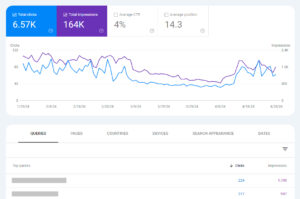The website is a product-based SaaS, targeting the US market.
The situation is unusual, as the company has its own SEO department, and the site did not have the typical errors that websites usually have after recent Google updates:
— The content in the blog and on the landing pages is written by real people, aligns with user intent, and is engaging to read; — Excellent EEAT with photos and details about employees; — No issues with query cannibalization, stolen content, or duplicate pages; — The link profile is free of toxic links and maintains a healthy dynamic.
Overall – everything is very commendable.
However, after March 5, organic traffic dropped by almost half.
After analysis, the following actions were taken:
- Removed the floating pop-up (promotion) on the mobile version, which covered almost the entire phone screen.
Google has a negative stance towards pop-ups covering the entire mobile screen.
- Added Google consent mode v2 banner instead of the old cookie banner.
What specifically was used:
WP plugin Complainz, as it is recommended by Google (https://cmppartnerprogram.withgoogle.com/#partners), covers all regions, and is easy to configure.
- Unloaded 4 SEO-overoptimized pages, in my opinion (1 landing page + 3 main blog posts).
What was specifically done:
Removed exact keyword phrases from most H2 titles and reduced their frequency within the text.
Reading became more convenient as a result.
No SEO tools were used to measure the number of incoming keywords – the focus was on ensuring the content was easy to perceive and read. That’s all.
After waiting a little over six weeks, traffic returned almost in full.
It’s difficult to pinpoint exactly what from the fixes caused the drop.
The conclusion I drew – attention should be paid not only to content and links.
A few seemingly insignificant errors on the site can create significant problems after Google’s next update.
